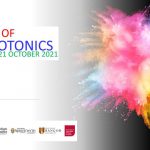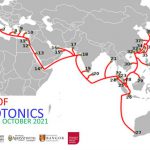
Photonics Phact #1
Did you know that it takes light just 1 second to travel 200,000km through a fibre optic cable? That’s the equivalent of 5 times around the Earth!

Photonics Phact #2
The word “Photonics” derives from the Greek word “Phos” or “Photos” meaning light. The word was first used in the 1960s to describe research relating to light performing functions that were analogous to those in electronics such as telecommunications.

Photonics Phact #3
The light we see on Earth is a form of energy that comes from the Sun.
It travels through space taking just over eight minutes to reach us.

Photonics Phact #4
Just like mixing paint to create a new colour, you can also mix light to create different colours.
The primary colours of light are red, green, and blue.

Photonics Phact #5
The diameter of a fibre optic cable is 10um, which is 5 times smaller than a human hair.

Photonics Phact #6
Lasers are the bedrock of many Photonics applications and come in a variety of shapes and sizes. We use tiny diode lasers to play DVDs or industrial-sized CO2 or fibre lasers in car manufacturing.

Photonics Phact #7
The World’s longest fibre optic link is 39,000km long! Our internet and phones rely on complex pulses of infrared laser signals sent over long distances across the globe.

Photonics Phact #8
The sensor on a smartphone camera is only about half a centimetre in size containing millions of pixels. These pixels are made from a material known as semiconductors that converts light to electrical signals.

